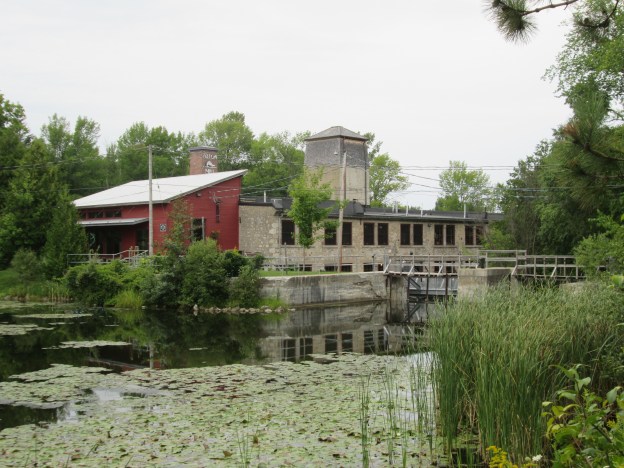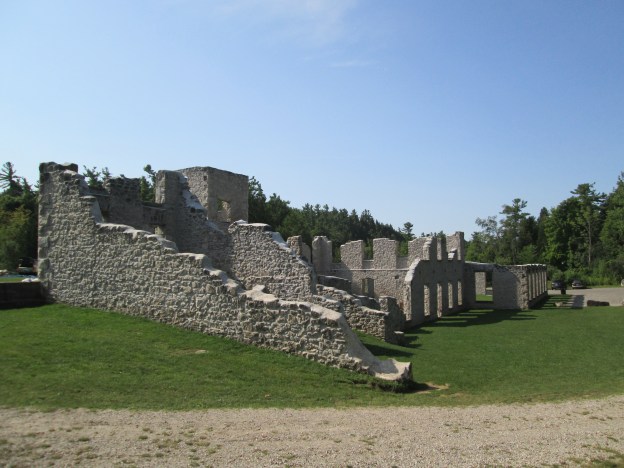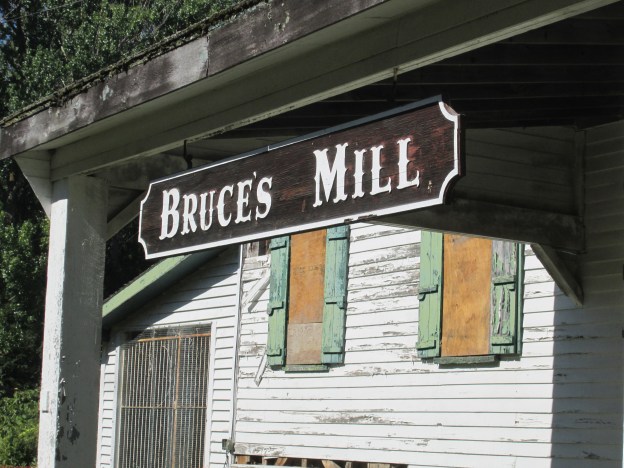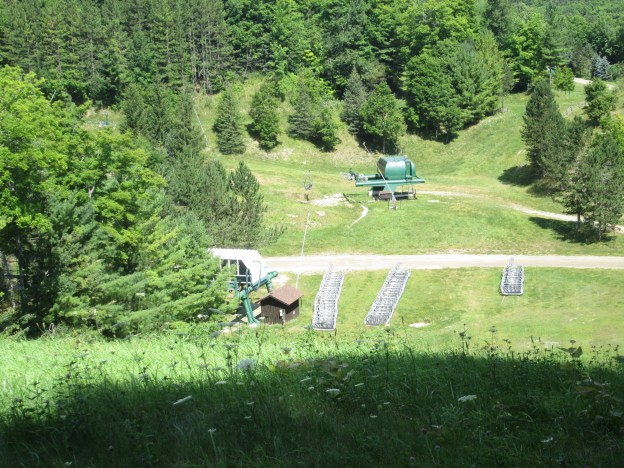Saturday August 29, 2015
Shaw’s Creek drops 108 feet through a mile long series of rapids making it ideal for water powered industry. At one point there were 8 dams and 12 mills operating along this stretch of the creek. We parked on Mississauga road and started to follow a fisherman’s path along the north side of the creek. It was overcast and 15 degrees but it soon became very hot and humid.
The community of Alton got it’s start in 1834 when Thomas Russell brought his family to lots 23 and 24 and the industrial history of Shaw’s Creek got underway. Within a couple of years other families arrived and saw and grist mills sprang up on Shaw’s Creek along the rapids. Mill owners built grand homes for themselves as well as smaller homes for the mill workers. One of the early mills was McClelland grist mill which was built in 1845 of frame construction. In 1881 Benjamin Ward built a four story stone building on the same site and opened Alton Knitting Mill. Ward’s son-in-law John M. Dods purchased the mills in 1892 and it became known as the Upper Mill, or Dod’s mill. The picture below shows the mill from upstream on the north side of the mill pond.
Two metal penstocks remain beside the building at the far side of the dam. The mill operated on a turbine whose intake can be seen just at water level in the previous photo. As water levels dropped the Dods were forced to install a coal powered generator for additional power.
The mills burned in 1917 and during restoration the third floor was converted into a water tower and sprinkler system to prevent future loss to fire. The mill operated until 1965 when it was closed and the equipment sold off. It has since been renovated into a conference centre known as Miilcroft Inn. The Little Mill pictured below was once a storage facility that was connected to the main mill by a catwalk made by Dick’s Foundry in Alton.
The Manor House is a large brick home which remains on the mill property. It belonged to the Ward and later the Dod families and has been landscaped with gardens and fountains.
In 1938 Edsel Ford, Henry’s son, introduced a new line of vehicles under the name of Mercury to fill a market niche between the standard Ford models and the luxury Lincoln models. From 1939 to 1951 the Mercury Eight was the only model offered under the Mercury name plate. We found this beautiful 1949 model parked in front of the Manor house whose porch can also be seen below.
With a store and a post office in 1855 it was time for a name and Alton was chosen. Soon it was home to a steam powered furniture factory operated by the King brothers, an axe factory, tannery, a foundery and saw mills, grist and flour mills as well as woolen mills. The building below sits on Queen Street and looks like an old wagon shop.
Behind it is one of several old dams and foundations located along the length of Shaw’s creek as it passes through the village.
The mechanic’s institute functioned as a library and was funded by local industrialists who thought that educating their employees was a win-win situation. William Algie sponsored the construction of the Alton mechanic’s institute in 1882 just a year after he founded his Beaver Woolen Mills. We had previously encountered a mechanic’s institute in the Forks of the Credit as seen in The Devil’s Pulpit.
Alton had five hotels when it was at it’s peak and it is lucky to have even one of them left today. The remaining building was originally known as the Dixie House but was badly damaged in a fire in 1890. It was rebuilt and today is known as Palmer House. It has two very large ornate lanterns on the second level, above the entrance.
In 1857 Charles Wheelock in his duties as provincial land surveyor identified nine mill privileges along Shaw’s Creek of which eight were eventually developed. In 1880 William Algie purchased privileges 5 and 6 on which sit the present mill and mill pond respectively. In 1881 he opened Beaver Knitting Mills which became famous for it’s fleece lined long underwear. The mill with it’s water tower, chimney and overgrown mill pond can be seen in the cover photo. The modern concrete dam can be seen below along with it’s art piece Head In The Ocean which takes it’s name from the fact that it was originally installed in the Bay of Fundy where the world’s highest tides covered it daily.
The mill was partially destroyed by fire in 1908 at which time it was reduced from 3 stories to today’s two story building. The fourth floor of the water tower was replaced with concrete during the restoration. When William Algie died in 1915 the mill was acquired by Dod’s knitting company who ran it until 1932 when it closed. The mill was used as a rubber factory from 1935 until 1982 producing balloons for Disney and condoms for soldiers during WWII, among other things. With the mill restored as The Alton Mill Studios a plan is underway to restore the mill pond and hopefully restore green power to the facility. An archival picture below shows the mill as it once looked.
On the hill above the mill stood the miller’s house. It has a large wrap around veranda that looks out over the mill pond and his milling empire. It also features a second story balcony solarium.
Alton had three churches including a Presbyterian, Methodist and this Congregational Church dating to 1877. The building has also served as a town hall and has a unique garage door in the rear.
Back near the car on Mississauga road we encountered a pair of wild turkeys with half a dozen young ones or poults. By 1909 the wild turkey had been wiped out in Ontario mostly due to loss of forest cover for the poults to be raised in. Between 1984 and 1987 4, 400 wild turkeys were re-introduced into locations across the province. With broods of 10 to 12 per year their numbers now total over 100,000 and they are hunted in both a spring and fall season.
There are many other remnants of dams and plenty of historic buildings that space doesn’t allow to appear here but which are well worth the exploration.
Here’s a checklist of popular hikes to take in before the season is over.
Visit us at http://www.facebook.com/hikingthegta
























































































